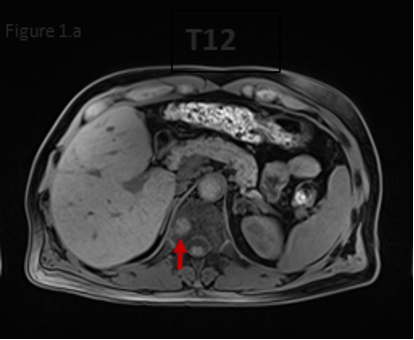Monday Poster Session
Category: Biliary/Pancreas
P2249 - Concurrent Primary Sclerosing Cholangitis and Acute Promyelocytic Leukemia: A Rare Case Report
Monday, October 27, 2025
10:30 AM - 4:00 PM PDT
Location: Exhibit Hall
- ME
Mohamad Elgozair, MD
Danbury / Yale New Haven Hospital
Danbury, CT
Presenting Author(s)
Mohamad Elgozair, MD1, Mohammed Y. Youssef, MD2, Lewis Roberts, MBChB, PhD3
1Danbury / Yale New Haven Hospital, Danbury, CT; 2Hunt Regional Medical Center, Greenville, TX; 3Mayo Clinic, Rochester, MN
Introduction: Primary sclerosing cholangitis (PSC) is a progressive inflammatory disease that affects the biliary tree, leading to fibrosis, bile duct strictures, and ultimately hepatic fibrosis. Acute promyelocytic leukemia (APL) is a rare subtype of acute myelogenous leukemia that typically presents with fatigue, weakness, and bleeding. To the best of our knowledge, we present the first reported case of the simultaneous occurrence of these two diseases.
Case Description/
Methods: A 58-year-old man presented with right upper quadrant pain and dark urine. Subsequent MRCP revealed narrowing of the common bile duct, consistent with PSC. One year later, he developed biliary dyskinesia and underwent cholecystectomy. Over the following years, the patient experienced multiple flares and was closely monitored with labs and imaging. Thirteen years after initial diagnosis, surveillance MRI revealed a new enhancing lesion in the T12 vertebra (Fig 1) and L5, suspicious for malignancy. Biopsy of the L5 lesion confirmed myeloid sarcoma, and the patient was started on arsenic trioxide and all-trans retinoic acid (ATO+ATRA). A repeat biopsy two months later showed resolution of the lesion. The patient began consolidation therapy, which was complicated by deranged liver enzymes. Labs at the time showed WBC 6.4, Hb 13.3, platelets 152, ALT 82, AST 87, total bilirubin 0.7, and alkaline phosphatase (ALP) 257, prompting temporary discontinuation of treatment. Imaging showed progression of PSC with increased peripheral biliary dilation and multifocal intrahepatic and extrahepatic biliary strictures, along with wall thickening and enhancement, raising concern for ATRA-related PSC progression.
Discussion: This case highlights a rare concurrence of PSC and APL, raising the question of a possible association between the two diseases. The observed PSC progression following APL diagnosis and treatment presents a clinical dilemma: whether the progression was drug-induced or simply reflects the natural course of PSC.

Figure: MRI showing a new enhancing lesion at the T12 vertebra, concerning for myeloid sarcoma in a patient with acute promyelocytic leukemia.
Disclosures:
Mohamad Elgozair indicated no relevant financial relationships.
Mohammed Y. Youssef indicated no relevant financial relationships.
Lewis Roberts indicated no relevant financial relationships.
Mohamad Elgozair, MD1, Mohammed Y. Youssef, MD2, Lewis Roberts, MBChB, PhD3. P2249 - Concurrent Primary Sclerosing Cholangitis and Acute Promyelocytic Leukemia: A Rare Case Report, ACG 2025 Annual Scientific Meeting Abstracts. Phoenix, AZ: American College of Gastroenterology.
1Danbury / Yale New Haven Hospital, Danbury, CT; 2Hunt Regional Medical Center, Greenville, TX; 3Mayo Clinic, Rochester, MN
Introduction: Primary sclerosing cholangitis (PSC) is a progressive inflammatory disease that affects the biliary tree, leading to fibrosis, bile duct strictures, and ultimately hepatic fibrosis. Acute promyelocytic leukemia (APL) is a rare subtype of acute myelogenous leukemia that typically presents with fatigue, weakness, and bleeding. To the best of our knowledge, we present the first reported case of the simultaneous occurrence of these two diseases.
Case Description/
Methods: A 58-year-old man presented with right upper quadrant pain and dark urine. Subsequent MRCP revealed narrowing of the common bile duct, consistent with PSC. One year later, he developed biliary dyskinesia and underwent cholecystectomy. Over the following years, the patient experienced multiple flares and was closely monitored with labs and imaging. Thirteen years after initial diagnosis, surveillance MRI revealed a new enhancing lesion in the T12 vertebra (Fig 1) and L5, suspicious for malignancy. Biopsy of the L5 lesion confirmed myeloid sarcoma, and the patient was started on arsenic trioxide and all-trans retinoic acid (ATO+ATRA). A repeat biopsy two months later showed resolution of the lesion. The patient began consolidation therapy, which was complicated by deranged liver enzymes. Labs at the time showed WBC 6.4, Hb 13.3, platelets 152, ALT 82, AST 87, total bilirubin 0.7, and alkaline phosphatase (ALP) 257, prompting temporary discontinuation of treatment. Imaging showed progression of PSC with increased peripheral biliary dilation and multifocal intrahepatic and extrahepatic biliary strictures, along with wall thickening and enhancement, raising concern for ATRA-related PSC progression.
Discussion: This case highlights a rare concurrence of PSC and APL, raising the question of a possible association between the two diseases. The observed PSC progression following APL diagnosis and treatment presents a clinical dilemma: whether the progression was drug-induced or simply reflects the natural course of PSC.

Figure: MRI showing a new enhancing lesion at the T12 vertebra, concerning for myeloid sarcoma in a patient with acute promyelocytic leukemia.
Disclosures:
Mohamad Elgozair indicated no relevant financial relationships.
Mohammed Y. Youssef indicated no relevant financial relationships.
Lewis Roberts indicated no relevant financial relationships.
Mohamad Elgozair, MD1, Mohammed Y. Youssef, MD2, Lewis Roberts, MBChB, PhD3. P2249 - Concurrent Primary Sclerosing Cholangitis and Acute Promyelocytic Leukemia: A Rare Case Report, ACG 2025 Annual Scientific Meeting Abstracts. Phoenix, AZ: American College of Gastroenterology.
